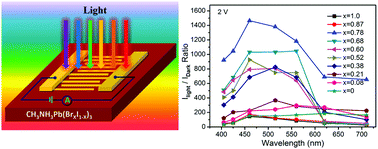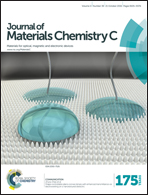Perovskite CH3NH3Pb(BrxI1−x)3 single crystals with controlled composition for fine-tuned bandgap towards optimized optoelectronic applications†
Abstract
A series of 10 perovskite CH3NH3Pb(BrxI1−x)3 (x = 0–1) single crystals have been prepared using a strategy of inverse-temperature reactive crystallization. Using individually optimized precursor solutions of CH3NH3PbBr3 in DMF and CH3NH3PbI3 in GBL, we succeeded in growing single crystals of CH3NH3Pb(BrxI1−x)3 with [Br] content x regulated in full-range from 0 to 1, which allowed bandgap fine-tuning from 1.53 to 2.24 eV, corresponding to absorption spectrum edge tweaked from green to red. This is considered a significant development because prior literature reports contain only small crystals <6 mm having two discrete compositions, namely Br/I = 15 : 1 (x = 0.94) and Br/I = 6 : 1 (x = 0.86). The dual-halide perovskite single crystals have been used to fabricate photodetectors. It is found that crystals with different compositions exhibit a selective optimal response spectrum. The photodetector based on a Br-rich composition (x = 0.78) exhibits optimum light-to-dark response ratio (Ilight/Idark > 1 × 103 under an incident light of ∼7.96 mW cm−2), rapid response speed (<4 ms), superior photodetectivity and excellent stability.


 Please wait while we load your content...
Please wait while we load your content...